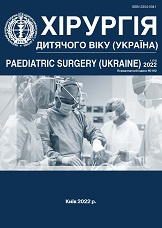Results of surgical correction or conservative management of splenic cysts in children according to remote monitoring changes
DOI:
https://doi.org/10.15574/PS.2022.74.56Keywords:
splenic cyst, children, surgical treatment, conservative management, resultsAbstract
Treatment of splenic cysts (SC) in children is variable and controversial. Depending on the size and location of these formations in the spleen, surgical correction is possible in open or laparoscopic surgery, or conservative (non-invasive) management. The result of SC treatment should be the complete elimination of the cyst cavity.
Purpose - to evaluate the results of surgical correction or conservative management of CS in children according to remote monitoring changes.
Materials and methods. We conducted the study on 265 children aged 0-17 years (mean age 11.25±4.21 years), who were examined and treated for SC. One hundred seventy-five (66.04±2.91%) children underwent surgery, and 90 (33.96±2.91%) patients received conservative treatment. We subjected all the information recorded in the medical records to statistical processing. The mentioned information could characterize the situation with the treatment process and with dynamic monitoring of this pathology to some extent.
Results. The most common localizations of cysts were the upper (33.21±2.89%) or middle segments of the spleen (29.81±2.81%). Almost every fourth patient (27.92±2.76%) with SC had pathology of other organs or systems, and every tenth (9.81±1.83%) had other diseases of the spleen. We detected residual cyst in 46.42±3.06% of patients; it underwent complete regression within 1-3 years. Residual cyst of small size (which persisted after surgical correction) regressed much faster after surgery compared with regression of cystic formation of small size in the spleen with conservative management (p<0.05).
Conclusions. Therapeutic tactics for SC in children involve different options for individual surgical correction or conservative management, depending on the location, size, relationship to the architecture of the main vessels and the variant of damage to the parenchyma of the spleen. The outcome of treatment of children with SC depends on the volume, location, etiology of the lesion, the method of correction and compliance with all recommendations in the postoperative period against the background of comorbidities.
The research was carried out in accordance with the principles of the Helsinki declaration. The study protocol was approved by the Local ethics committee of all participating institutions. The informed consent of the patient was obtained for conducting the studies.
No conflict of interests was declared by the authors.
References
Czauderna P, Vajda P, Schaarschmidt K et al. (2006). Nonparasitic splenic cysts in children: a multicentric study. Eur J Pediatr Surg. 16: 415-419. https://doi.org/10.1055/s-2006-924748; PMid:17211790
Delforge X, Chaussy Y, Borrego P, Abbo O et al. (2017). Management of nonparasitic splenic cysts in children: A French multicenter review of 100 cases. J Pediatr Surg. 52 (9): 1465-1470. https://doi.org/10.1016/j.jpedsurg.2017.01.054; PMid:28185630
Esposito S, Leonardi A, Penta L, Prestipino M, Bertozzi M. (2019). Giant epidermoid cyst of the spleen in a pediatric patient. A case report. Medicine. 98 (27): e15653. https://doi.org/10.1097/MD.0000000000015653; PMid:31277087 PMCid:PMC6635292
Fisher JC, Gurung B, Cowles RA. (2008). Recurrence after laparoscopic excision of nonparasitic splenic cysts. J Pediatr Surg. 43: 1644-1648. https://doi.org/10.1016/j.jpedsurg.2007.12.052; PMid:18779000
Garza-Serna U, Ovalle-Chao C, Martinez D, Flores-Villalba E, Diaz-Elizondo JA, Garza-Luna U de J. (2017). Laparoscopic partial splenectomy for congenital splenic cysts in a pediatric patient: case report and review of literature. Intern J Surg Case Rep. 33: 44-47. https://doi.org/10.1016/j.ijscr.2017.02.013; PMid:28267665 PMCid:PMC5338892
Gezer HÖ, Oğuzkurt P, Temiz A, İnce E et al. (2016). Spleen salvaging treatment approaches in non-parasitic splenic сysts in сhildhood. Indian J Surg. 78 (4): 293-298. https://doi.org/10.1007/s12262-015-1373-x; PMid:27574347 PMCid:PMC4987555
Hassoun J, Ortega G, Burkhalter LS, Josephs S, Qureshi FG. (2018). Management of nonparasitic splenic cysts in children. J Surg Research. 223: 142-148. https://doi.org/10.1016/j.jss.2017.09.036; PMid:29433866
Ingle SB, Hinge CR, Patrike S. (2014). Epithelial cysts of the spleen: A minireview. World J Gastroenterol. 20 (38): 13899-13903. https://doi.org/10.3748/wjg.v20.i38.13899; PMid:25320525 PMCid:PMC4194571
Kenney CD, Hoeger YE, Yetasook AK et al. (2014). Management of nonparasitic splenic cysts: does size really matter? J Gastrointest Surg. 18: 1658-1663. https://doi.org/10.1007/s11605-014-2545-x; PMid:24871081
Khan Z, Chetty R. (2016). A review of the cysts of the spleen. Diagnostic Histopathology. 22 (12): 479-484. https://doi.org/10.1016/j.mpdhp.2016.10.002
Prytula VP, Krivchenya DYu, Kuzyk AS, Hussaini SF, Silchenko MI. (2019). Laparoscopic treatment of splenic cysts in children. Paediatric Surgery. Ukraine. 2 (63): 36-40. https://doi.org/10.15574/PS.2019.63.36
Schier F, Waag KL, Ure B. (2007). Laparoscopic unroofing of splenic cysts results in a high rate of recurrences. J Pediatr Surg. 42: 1860-1863. https://doi.org/10.1016/j.jpedsurg.2007.07.012; PMid:18022436
Sinha CK, Agrawal M. (2011). Nonparasitic splenic cysts in children: Current status. The Surgeon. 9: 49-53. https://doi.org/10.1016/j.surge.2010.08.005; PMid:21195332
Smith ST, Scott DJ, Burdick JS, Rege RV, Jones DB. (2001). Laparoscopic marsupialization and hemisplenectomy for splenic cysts. J Laparoendosc Adv Surg Tech. 11: 243-249. https://doi.org/10.1089/109264201750539781; PMid:11569516
Tartar T, Bakal U, Sarac M, Kazez A. (2020). Laboratory results and clinical findings of children with hydatid cyst disease. 23 (7): 1008-1012. https://doi.org/10.4103/njcp.njcp_531_19; PMid:32620733
Till H, Schaarschmidt K. (2004). Partial laparoscopic decapsulation of congenital splenic cysts: a medium-term evaluation proves the efficiency in children. Surg Endosco Inter Tech. 18: 626-628. https://doi.org/10.1007/s00464-003-9046-4; PMid:15026897
Downloads
Published
Issue
Section
License
Copyright (c) 2022 Paediatric Surgery (Ukraine)

This work is licensed under a Creative Commons Attribution-NonCommercial 4.0 International License.
The policy of the Journal “PAEDIATRIC SURGERY. UKRAINE” is compatible with the vast majority of funders' of open access and self-archiving policies. The journal provides immediate open access route being convinced that everyone – not only scientists - can benefit from research results, and publishes articles exclusively under open access distribution, with a Creative Commons Attribution-Noncommercial 4.0 international license(СС BY-NC).
Authors transfer the copyright to the Journal “PAEDIATRIC SURGERY.UKRAINE” when the manuscript is accepted for publication. Authors declare that this manuscript has not been published nor is under simultaneous consideration for publication elsewhere. After publication, the articles become freely available on-line to the public.
Readers have the right to use, distribute, and reproduce articles in any medium, provided the articles and the journal are properly cited.
The use of published materials for commercial purposes is strongly prohibited.

